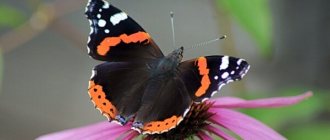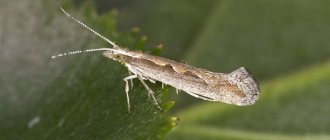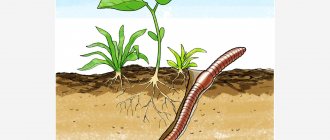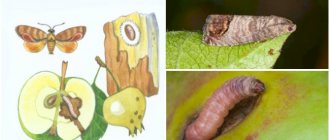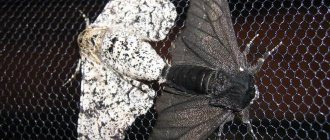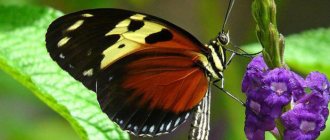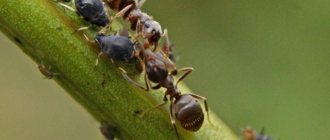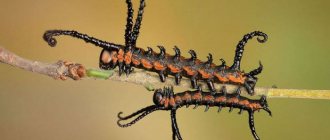Views: 272
The cabbage white butterfly (lat. Pieris brassicae) or, as it is also called, the cabbage butterfly belongs to the class insects, the order Lepidoptera and the white butterfly family. This is the most common as well as famous species of butterfly. You can meet her starting in April, fluttering over the first plants and spring flowers until mid-autumn. However, a butterfly that is harmless at first glance is capable of causing irreparable damage to a farm, since its larvae are unusually voracious.
Description of the species
Belongs to the whitefish family. It got its name because it prefers to eat cruciferous plants, in particular cabbage.
You can recognize a butterfly by the following parameters:
- Body structure. Has 4 wings and a dark body.
- Color. Mostly white. Females have black spots on their wings.
- Wingspan. Reaches 6 cm in females. In males this figure is lower.
- Larvae. Stay in groups, have ocher-colored bodies.
- Caterpillars. They can be distinguished by their greenish color. White stripes are visible on the body, which are located along the entire body of the pest. The size of the pests is 2-3 cm.
Description and features of the cabbage butterfly
The wingspan of the cabbage butterfly in males ranges from 4.9 cm to 6.2 cm, in females it reaches 6.3 cm. The wings themselves are powdery white, 3.3 cm long (the upper ones, the lower ones are smaller). In females, the tips of the forewings have characteristic black markings on the leading edge, as well as two black dots in the center. In addition, they have a single club-shaped spot on the leading edge of the hind wings. Males are also distinguished by the colored tips of the front wings, but there are no spots on them, but there is one black spot on the hind wings.
When the cabbage butterfly lands, its wings close and it becomes almost invisible, since their inner side is yellowish-green, which allows it to blend into the plant. This natural camouflage is especially visible in second and third generation butterflies. The reverse side of their wings is brighter colored than those of the first generation.
The butterfly is characterized by uneven flight, but great flight endurance.
The butterfly's body is shaggy, with three pairs of legs, at the end of which there are sharp claws that allow it to stay on plants even in strong winds. However, the cabbage duck's legs are weak and it crawls poorly, so the main way to move is by flying. A feature of this species is its well-developed sense of smell and vision.
Most of the head is occupied by huge faceted eyes. This allows insects to easily find brightly colored flowers. In addition, butterflies have long whiskers with a thickening at the end, which are also involved in recognizing edible plants.
An adult butterfly caterpillar has a body up to 3.5 cm long, greenish-blue in color with 8 pairs of legs and two short antennae. The entire body is covered with black hairs and spots, and three longitudinal yellow stripes are clearly visible - one on the back and two on the sides. An interesting feature of caterpillars is the poisonous secretion they secrete, which makes them uninteresting to birds. There are known cases of death of birds who decided to feast on cabbage larva. Also, these secretions are dangerous for humans, causing irritation of the skin.
Therefore, it is not recommended to collect pests from cabbage leaves with bare hands.
Lifespan and cycles
There are 4 stages in the life cycle of cabbage butterflies.
Egg
The number of eggs that 1 cabbage plant lays depends on the climate in the region. In areas with a predominantly warm climate, butterflies breed more often.
Oviposition occurs from April to September.
When wintering ends, butterflies immediately begin breeding. After mating, the female lays about 200 eggs on cruciferous plants. Most often, the 1st generation does not cause harm to agriculture, since oviposition occurs on wild cruciferous vegetables. But the 2nd generation of butterflies prefers to lay eggs in vegetable gardens.
Caterpillar
Depending on external conditions, it may appear 2-3 weeks after egg laying. As soon as the larvae grow, they disperse over the cabbage leaf and begin to gnaw it from the underside from the edges to the veins.
As a caterpillar, cabbage grass can survive up to 40 days. During this time, she changes the outer shell several times, doing this every 5-7 days. To maintain normal life, they require dry weather with a temperature of no more than 25 degrees.
The most harmful life form of cabbage.
Doll
Outwardly it resembles a caterpillar, but does not cause severe harm to plants. It attaches to individual parts of the cruciferous plant and stays in this form for up to 2 weeks. If the season comes to an end, the cabbage plant goes into hibernation and hatches from the cocoon only when the weather warms up.
Adult
An adult butterfly lives about 30 days. At the same time, it can cause great harm to agriculture by laying eggs on cabbage leaves.
other methods
The reproduction and development of the butterfly is significantly hampered by various diseases. For example, a bacterial culture of wax moth is often used, which provokes illness and subsequent death of caterpillars. Flycheria is of particular importance among bacteriological pathologies. Caterpillars affected by it stop growing, become lemon-yellow in color and quickly die. Inside, the tissues of the infected individual turn to mush. One of the races of Trichogramma (egg eater) may also appear in white eggs.
One of the simplest methods for exterminating white butterflies is considered to be regular inspection of the lower surface of the leaves of cruciferous plants and crushing of the laid eggs. Manual collection of caterpillars and their destruction is used. In addition, quite a lot of insecticidal preparations are produced today. They are used to spray the future crop at the beginning of the season to prevent the appearance of pests, as well as at their first appearance to destroy young individuals. Treatment of plants prevents further growth of caterpillars and protects crop leaves from damage.
How to get rid of cabbage butterfly?
To make pest control effective, you need to remember these tips:
- Complex fight. It is recommended to use several methods of exterminating insects at once. Treat not only the affected plants, but also those located nearby.
- Timely detection. It is necessary to periodically inspect crops for the presence of pests.
- Follow sowing rules. Some crops may be particularly attractive to cabbage weeds, which makes nearby plants vulnerable to the pest.
- Use the products correctly. It should be remembered that chemicals are more toxic. If they are used at the head formation stage, harmful substances can accumulate in the leaves of the plant, making it unfit for consumption.
Biological
Among the popular methods of biological pest control are:
- Small belly. This insect is parasitic, laying its eggs in cabbage larvae, which leads to their death. The small belly is capable of destroying about 90% of caterpillars.
- Trichogramma. Another parasite that infects cabbage eggs.
- Flascheria. A disease caused by wax moth bacteria. Infected caterpillars turn a bright yellow color and soon die.
Attracting birds to the site is ineffective because the caterpillars produce a liquid that is poisonous to birds.
You can also use the following medications:
- Fitoverm;
- Vermicide;
- Actofid.
They contain bacteria that are inedible to the caterpillars.
Biological methods are effective only for small areas affected by cabbage weeds.
Chemical
In case of a massive pest invasion, it is better to use chemicals.
Common means:
- Karate;
- Spark;
- Kinmiks.
Treatment is best carried out in dry and sunny weather, when there is no wind outside. The lower part of the leaves should be sprayed, as this is where the caterpillars usually hide.
Be sure to use protective equipment. Care should be taken to have a mask, special glasses, gloves and clothing made of fabric that is impermeable to poison.
Folk remedies
A simple folk method of getting rid of caterpillars is to collect them by hand. But you need to wear gloves, since the liquid from the caterpillars causes irritation on the skin. This method is effective if there are few parasites.
Effective recipes:
Pine needle concentrate. What to do:
- take 200 g of cones;
- pour 1 liter of hot water;
- leave for 1 week;
- strain;
- place in the refrigerator.
For spraying, mix the infusion with water in a ratio of 1 to 10.
Ash and soap. For preparation:
- take 500 g of sifted wood ash;
- mix with 10 liters of water;
- let it brew for 3-4 hours;
- add 2 tbsp. l. liquid soap.
Use the product immediately after production.
Syrup trap. Recipe:
- take thick sugar syrup;
- mix with yeast in a ratio of 1 part yeast to 5 syrup.
Divide the resulting mixture into saucers and place them between the rows. Check periodically to see how many butterflies are caught in the trap.
Mustard powder. Procedure:
- take 100 g mustard powder;
- mix with 10 liters of water;
- leave for 2-3 days.
Before use, mix the product with a small amount of water.
Use of wormwood. Instructions:
- take 1 kg of wormwood leaves;
- chop well;
- fill with a small amount of water (1-2 l);
- simmer over low heat for 15 minutes;
- strain.
Dilute the decoction with 10 liters of water and spray. Repeated treatment can be carried out only after 7 days.
Valerian infusion. Mode of application:
- take 1 bottle of valerian infusion;
- mix with 3 liters of water.
Spray the leaves with the prepared solution.
Herbal infusion. What actions to take:
- take 200 g each of wormwood, burdock and yarrow;
- pour 2 liters of hot water;
- leave for 2-3 days.
Strain well and use.
Nutrition
Cabbage whiteweed eats cruciferous plants. Young caterpillars, being together for the first time, feed on the pulp from the lower part of the leaves, leaving the upper skin. Then the individuals spread throughout the plant. Cabbage grass begins to eat leaves mainly from the edges, adult caterpillars crawl to the upper surface. They gnaw the flesh, leaving only the rough veins. Butterflies prefer to fly during the daytime. They feed (except for the pulp of leaves) on plant nectar. Large concentrations of individuals can be found in areas protected from the wind and located near fences and tree plantations. In large areas sown with cabbage, the pest, as a rule, settles along the edges of the field.
Prevention methods
The appearance of parasites can be prevented if you use simple prevention rules:
- Washing off the pupae. All wooden fences around the area should be thoroughly washed with running water to get rid of pupae stuck to them.
- Timely weeding. Weeds, especially those from the cruciferous family, need to be removed at the early stages of their appearance. Otherwise, they may attract pests.
- The right neighborhood. Radishes, radishes, and turnips should not be planted nearby. It is better to plant marigolds, lemon balm, and mint around the area, whose smell repels the butterfly. You can also plant dill or carrots between the rows, as they attract cabbage's natural enemies.
- Shelter for plants. Even at the seedling stage, cabbage can be covered with an impenetrable cloth, which will protect against cabbage infestation.
- Burning the area. In the fall, after harvesting, you need to burn the area where the cabbage grew. This will help improve soil quality and kill any remaining pupae.
- Use of prophylactic agents. During the period of active growth of cabbage, it is necessary to periodically treat the leaves with biological preparations. For example, Fitoverm.
- Tree protection. It is also better to wash nearby trees. Treat the trunk with lime.
- Scaring away. You can scare away butterflies using half an eggshell placed on a wooden post. The butterfly mistakes such a structure for another representative of the species and, deciding that the place is already occupied, flies past.
You can learn about the correct preparation of a repellent to prevent cabbage infestations by watching this video:
Damage caused by the cabbage butterfly
The fully grown adult caterpillars are quite voracious and will destroy the leaves of cabbage and other plants in a short time if they are not stopped. The result of the larvae's activity is the remaining veins from the leaves.
In addition, caterpillars can provoke diseases of crops such as cabbage, radish, horseradish, mustard and other members of the cruciferous family. The result of their vital activity is particles of excrement that remain between the leaves. They penetrate inside, attract harmful insects and deteriorate the condition of the greenery.
The easiest way to protect cabbage from pests: cabbage butterfly
Reviews
To learn more about the effectiveness of methods for preventing and exterminating cabbage weeds, you should read the opinions of people who have already had to deal with the pest.
★★★★★
Ivan, 51 years old. I have known about the dangers of cabbage for a long time.
One day, an invasion of caterpillars destroyed almost the entire crop. Since then I have been using Fitoverm. I treat the leaves with it for prevention and in case of minor lesions. Manages to keep the cabbage intact. ★★★★★
Irina, 62 years old. I prefer folk remedies for pest control because they are more natural and do not affect the quality of vegetables.
Pine needle concentrate works best. And if there are only a few caterpillars, I collect them by hand. The main thing is to wear gloves. ★★★★★
Galina, 45 years old. I believe that the best way to combat cabbage is timely prevention.
Therefore, in the fall I burn the area, and in the spring I plant marigolds around the beds. I prefer to do mixed plantings, so I sow carrots between the rows of cabbage. My harvest remains intact. Hide
Add your review
To protect the crop from the invasion of cabbage weeds, you need to take preventive measures in a timely manner. Today, there are a large number of drugs and recipes, the use of which will help cope with pests.
0
0
Copy link
Stages of development: description
The cabbage butterfly develops in the same way as all insects with a complete transformation cycle, which occurs in 4 stages:
- egg;
- larva or caterpillar;
- chrysalis;
- adult or imago.
Scientists in the last century noticed one interesting feature of the insect - the butterfly is very careful about its offspring. The female never lays eggs on leaves where eggs have already been laid by another individual. It is assumed that the butterfly determines by smell that the leaf is already occupied.
How to control pests
Measures to destroy cabbage whites should be taken as early as possible, during the first spring summer. For successful control, it is recommended to combine prevention, traditional methods and chemical remedies. The latter are used in case of severe damage to garden crops.
Agricultural technology
An important point is the preparation of plantings.
In the fall, preparing the site for winter, you need to carefully dig up the beds, removing debris, plant roots and other foreign matter. It is necessary to get rid of weeds, especially those belonging to the cruciferous family: cress, wild radish, grasshopper, shepherd's purse. Flowering plants attract butterflies, which willingly switch to cultural plantings.
When planting cabbage, horseradish, turnips and other cruciferous vegetables, it is important to follow the following rules:
- It is better to sow cabbage and radishes on land that was occupied by tomatoes, eggplants or zucchini last year.
- Cabbage should be sown as early as possible, before the first summer of butterflies.
- If it is cold outside, it is better to plant early varieties of cabbage in a greenhouse or greenhouse.
- It is worth placing eggplant or tomato bushes between the rows: the smell of their tops repels butterflies. Marigolds, calendula, and dill will be a good addition to plantings.
Throughout the season, it is important to inspect the undersides of cabbage leaves and the tops of radishes and radishes. Regular collection of egg clutches will help reduce the whitefish population. Immediately after the caterpillars hatch, they are also collected by hand: in the first days the larvae are inactive.
Folk remedies for controlling cabbage whites
Folk remedies are considered the safest and most environmentally friendly. They do not accumulate in the soil and can be used at all stages of plant development. The compositions are easy to prepare at home, they are economical and harmless to people and pets.
Gardeners most often use the following compositions:
Tobacco dust. A popular product for protecting cultivated plants. The powder can be scattered on the beds in dry form or prepared as a solution for spraying. To prepare the liquid mixture, you need to dissolve 0.5 cups of tobacco dust and wood ash in 5 liters of warm water, add 1 tbsp. l. dry mustard. The mixture is infused for 24 hours. Spraying is carried out at least 2 times a week.
Infusion from potato or tomato tops. Substances contained in nightshade tops have a detrimental effect on caterpillars and repel adult butterflies. To prepare 600 g of dry tops, pour 10 liters of water and leave for at least 3 hours. After filtering, add 40 g of grated laundry soap to the liquid.
Wormwood infusion. A reliable remedy against many insect pests. 1 kg of slightly dried raw material is poured into 2 liters of water and boiled for about 10 minutes. After cooling, filter the broth and add another 8 liters of water. Plantings are sprayed 2 times a week, making sure that the liquid moistens each leaf generously. An alternative option is to place cut wormwood stems in the rows, renewing them periodically.
Vinegar solution. Suitable for the prevention and destruction of insects in case of minor damage to plantings. 3 tbsp. l. Dilute 9% vinegar in a bucket of water. You can add 1 tsp. ground black pepper and 2 tbsp. l. mustard. The solution should be prepared immediately before use, and the plantings should be sprayed 2-3 times a week.
Ammonia. A good preventative, harmless to all varieties of cabbage. The ammonia is diluted with an equal amount of water, the plantings are sprayed every 2-3 weeks until harvest.
Baking soda. Has a drying effect and is effective against small numbers of insects. The powder is generously sprinkled on the plantings, renewing after each rain.
Expert opinion
Mityuk Stefania Bogdanovna
To spray plantings, you can use infusions of valerian, tansy, and pine needles.
Biological drugs
These drugs occupy an intermediate position between folk remedies and potent chemical insecticides. Bio-protection is based on the use of bacteria, viruses and fungi that are safe for plants, animals and humans, but have a detrimental effect on insects.
Among the most popular drugs:
An insectoacaricide that causes paralysis and rapid death of pests, including cabbage whites. The main component is abamectin. The action begins a day after intensive spraying and does not cause addiction among pests. The protective effect lasts up to 3 weeks. The last treatment can be carried out 3 days before harvest. The only negative is that the composition is dangerous for bees.
A preparation based on spore-forming soil bacteria. Effective on some species of Lepidoptera, including cabbage whites. Effectively destroys caterpillars and adults, repels adult insects. Valid for 5 days after application, safe for plants. Can be used throughout the entire development cycle of cruciferous vegetables, including several days before harvest.
The active substance is aversectin, obtained from soil fungi. The drug is effective against any butterfly pests and destroys both adult insects and caterpillars. Recommended for use in warm weather, the product is effective for up to 20 days after spraying. Can be applied immediately before harvest.
Nicotine-based drug. Destructive for many types of garden pests, including cabbage whites. Recommended during the growing season, it fights caterpillars at all stages of development. The drug is low-toxic, but it is better not to use it at the end of the ripening of vegetables.
The principle of using bio-insecticides is simple. The drug is diluted according to the instructions on the package and sprayed onto plants and soil using a hand pump. Particular attention is paid to the underside of large leaves and tops.
Treatment is carried out immediately after detection of pests. If there are few of them, a one-time spray is enough. With increased reproduction of the whitefish, repeated treatment is possible after 1-2 weeks. Spraying is carried out in warm, windless weather. The drugs are completely absorbed after 2-3 hours.
Chemicals and rules for their use
Chemical insecticides are used in case of severe damage to plants. They cannot be used immediately before harvest; the optimal time is the first 2-3 weeks after planting. Chemicals are also not recommended for processing cabbage: during the period of cabbage formation, toxic components remain between the leaves and are almost impossible to remove.
Insecticides are sprayed not only on plants, but also on the soil. A respirator or mask, rubber gloves and other protective equipment are required.
Among the most effective means:
Pesticides
They affect many pests in the caterpillar and larval stages. When eating treated leaves, insects become immobilized and quickly die. The drugs act for a long time and can be combined with each other.
Pyrethroids
It protects well all cruciferous plants and does not accumulate in the soil. Toxicity is average, can be used to treat cabbage seedlings. Destroys insects at all stages of development.
Chitin synthesis inhibitors
Highly effective products that kill parasites resistant to other insecticides. Low toxicity, do not accumulate in soil, harmless to bees.
The list of effective drugs of varying degrees of toxicity includes Karbafos, Actellik, Commander, Confidor, Bi-58, Kinmiks. Concentrated formulations are diluted with water in accordance with the instructions. Treatment is carried out 1-2 times per season.
